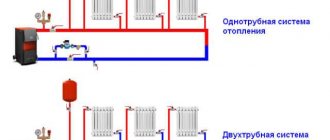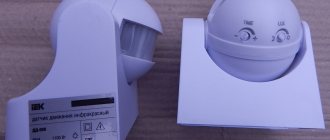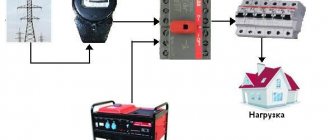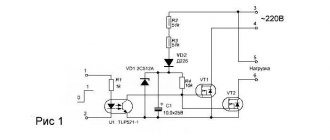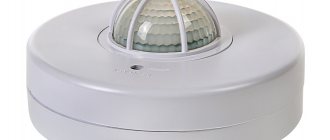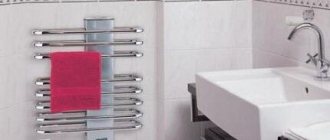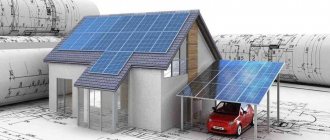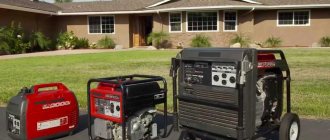Some simple models of electric boilers do not have smooth power adjustment, not to mention wider functionality. But even with degree-by-degree adjustment, the operation of the automation is based on measuring the temperature of the coolant in the supply and return of the boiler, which is not entirely effective: high accuracy cannot be achieved; high inertia is characteristic, i.e. a rather slow change in air temperature in the house.
But the main thing is that in the absence of precise adjustments, a lot of electricity is wasted.
The problem can be solved by installing a special room thermostat (thermostat) for an electric boiler, more expensive models of which measure the air temperature in the room and regulate the boiler operating mode in accordance with it, which is more correct and, most importantly, allows you to save from 10 to 50% of electricity. Moreover, the price of the issue is only 800-1000 rubles for simple mechanical models or 3-5 thousand rubles for more functional programmable thermostats controlled from a phone.
What are thermostats for an electric boiler?
Why are they needed and how are they used?
Simple mechanical thermostat.
The temperature regulator is a wired or wireless control panel that is mounted on the wall in any convenient place.
There are both simple mechanical models, the functionality of which is smooth degree-by-degree temperature control (especially important for electric boilers with mediocre 3- or 6-step power control), and automatic programmable models with an information display, which allow you to configure more than 50 parameters of the boiler operation and program them change for the next day or even week.
Automatic thermostats allow you to adjust the operation of the boiler once and up to a whole or even several heating seasons.
In general, room thermostats for electric boilers perform the following functions:
- measurement, control and maintenance of a certain comfortable temperature of the working environment;
- transmitting signals to the electric boiler from any place in the house convenient for the owner;
- protection against overheating or freezing of the heating system;
- programming the operating mode for the next day or week;
- remote control from a phone if the thermostat has Wi-Fi or a GSM module;
- remote notification (including via smartphone) about malfunctions and emergency situations in the operation of the heating system.
Existing types
The settings specified on the thermostat take precedence over the settings of the electric boiler itself. The operating principle of the device depends on the type of temperature sensor used in it:
1. Mechanical thermostats
The simplest models, the operating principle of which is based on the operation of membrane and capillary temperature sensors. They use substances placed in a capsule that expand significantly at the slightest increase in temperature. When the expanding substance reaches the maximum temperature threshold, it puts pressure on the relay membrane, as a result of which the contacts open, and the thermostat sends a signal about a partial or complete reduction in the power of the electric boiler.
The main disadvantages of such thermostats are simple functionality, limited to turning a round rotator to set the desired temperature, and a high error - up to 3-4°C.
2. Electromechanical
They have a more complex design based on the use of special metal plates as a heat-sensitive element, which produce a micro-discharge when heated to a certain temperature. The micro-discharge activates an electromagnetic relay that controls a mechanical valve. In general, electromechanical thermostats have +- the same functionality, but a much smaller error; their cost is 20-40% higher.
3. Electronic
The most modern and multifunctional devices, equipped with electrical boards (automation), often with remote sensors: both internal and external (street). Capable of maintaining or changing the operating mode of an electric boiler without human intervention. Allow a minimum error of up to 0.5-0.7 degrees. We recommend paying attention to electronic thermostats due to their functionality and cost-effectiveness.
The automation of modern models is capable of maintaining the most economical mode of operation of the electric boiler, constantly adjusting its operation in accordance with the temperature in the working room, which completely prevents unnecessary energy consumption. After all, reducing the temperature by 1°C is up to 5% savings.
How to choose an external temperature sensor and organize weather-dependent boiler control
Conclusions and useful video on the topic
There should not be any particular difficulties with installing the thermostat. You just need to choose it correctly for a specific heating system. And the selected video materials will definitely help you with this.
Video #1. Connecting a room thermostat to a gas boiler in all its nuances:
Video #2. Wall thermostat review:
Video #3. Technology for incorporating a contact thermostat into a system with a circulation pump:
An addition to a heating boiler in the form of a thermostat is a great way to save money on heating your home, increase living comfort and reduce wear and tear on equipment that heats the coolant. The money spent on thermostats pays off in one winter season.
In this case, you can choose either a simple mechanical option with manual control or a more advanced device with a programmer.
Would you like to tell us how a boiler with a thermostat works in your country house? Do you have information that will be useful to site visitors? Please write comments, ask questions, post photos related to the topic of the article in the block below.
- Author: Maria Sukhorukikh
Rate this article:
- 5
- 4
- 3
- 2
- 1
(0 votes, average: 0 out of 5)
Share with your friends!
How to choose a room thermostat for an electric boiler
Mounting and connection method
According to the technique of fastening and connecting to the electric boiler, wired and wireless devices are distinguished.
Wired thermostats can still be installed in any room, can have any functionality, but require a wired connection directly to the electric boiler. Their cost is lower, and in most cases the connection wire is included.
Wireless temperature controllers consist of a control panel and a radio signal receiver connected to the electric boiler by wire. The advantages are obvious: when placing the thermostat in a room remote from the installation site of the electric boiler, there is no need to lay an additional electrical wire through the entire house.
According to practice, a radio signal with a frequency of 433 or 868 MHz intended for household appliances does not affect other electronics in the house and is transmitted without problems through any walls at a distance of 20 and even 30 meters. The disadvantage is the need for additional power for the control panel, usually 2 standard AA batteries.
Functionality
Standard simple models only have an on/off switch and a rotator (or “+” “-“ buttons) to set the temperature.
For significant savings, it is better to choose a more expensive programmable thermostat, which will pay for itself in the first few months of use. With its help, you can reduce the room temperature to 15-16°C when everyone has gone to work, or to 18-19°C at night. It is enough to set up several electric boiler operating patterns once, the duration of which can range from 8 hours to 7 days.
In addition, programmable models, in addition to the built-in temperature sensor, are often equipped with additional remote ones, including those for heated floors.
Availability of Wi-Fi or GSM module
The built-in GSM module allows you to receive notifications via SMS messages about the operation of the heating system or about an emergency situation that has occurred, which you can immediately solve. This way the coolant will not freeze during a long absence of the owners.
The presence of Wi-Fi allows you to control the operation of the electric boiler through an application on your smartphone. Also, via a Wi-Fi network, you can connect a thermostat to a smart home system or connect several additional temperature sensors (including underfloor heating). The presence of Wi-Fi and GSM does not affect the efficiency and economy of the heating system, but increases the comfort of its use.
Protection and safety
Budget and even some models of electric boilers in the mid-price segment may lack basic safety elements such as overheating protection, frost prevention mode, or protection against stopping the circulation pump. However, all these elements are found even in many simple models of thermostats in the price range of 1,000-1,500 rubles.
Such security systems especially should not be neglected when temporarily living in a house, when the owners are absent for days or weeks, but the heating system maintains a positive temperature.
Thermostatic control valves
The thermostatic valve is a simple solution to the problem of obtaining a coolant at a given temperature by mixing colder water with warmer water. The three-way valve is shown below:
Three-way valve
Scheme for connecting a three-way valve to the heating system:
Scheme for connecting a three-way valve to a heating system
Piping diagram for a solid fuel boiler using a thermostatic three-way valve:
Piping diagram for a solid fuel boiler using a thermostatic three-way valve
Piping diagram for a gas boiler using a thermostatic three-way valve:
Piping diagram for a gas boiler using a thermostatic three-way valve
The thermostatic radiator valve allows you to control the temperature in the room by varying the flow of hot water through the radiator. They regulate the flow of hot water through the radiator, but do not control the boiler. Such devices must be installed to adjust the temperature needed in each individual room.
This idea should be considered as an addition to the thermal control installation. Also, such devices require periodic readjustment and regular performance checks (every six months when changing operating modes).
The best known manufacturers and models: characteristics and prices
Cewal RQ-10
One of the simplest and most budget-friendly mechanical thermostats from an Italian manufacturer. Despite its low cost, it is known for its build quality and reliability. The instructions for the device provide a schematic and detailed description of the installation and connection algorithm. The only drawback is the large hysteresis - up to 1.5-2.5 degrees, which is typical for all mechanical thermostats.
SKAT Teplocom TS-2AA/8A
A more advanced thermostat with an error of up to 1°C. It has a micro-display for indicating temperature, powered by 2 AA batteries (enough for 10-15 months). It features an economical night mode with automatic temperature reduction by 4°C and frost protection.
Danfoss ECtemp Next Plus
One of the best thermostats for an electric heating boiler in terms of price-quality-functionality. It is a modern electronic programmable thermostat with a stylish design and wide functionality. In addition to the built-in one, it has an external wired temperature sensor for heated floors, which allows control separately from the air temperature in the room. Wide functionality, programming and the presence of ready-made modes (“night”, “away”, etc.) allow for maximum energy savings.
It is also distinguished by its safety: it has protection against overheating and freezing, child locking, and monitoring the health of temperature sensors. According to installation practice and owner reviews, there were no cases of malfunction. To avoid malfunction, during installation it is necessary to accurately fit into the grooves of the plug connector.
TEPLOLUX MCS-350
A modern multifunctional premium thermostat with a built-in Wi-Fi module and the ability to control using a special application for a smartphone. It features one of the most extensive functionality, an informative touch screen (with automatic locking) and a stylish design. The kit includes both built-in and remote temperature sensors for simultaneous or separate control. Additionally, you can connect up to 32 temperature sensors.
There are template energy-saving operating modes and weekly programming, as well as energy consumption statistics. The connection must be made via a modular contactor.
Unknown error
An unknown error has occurred
Showing results for
No results found for
Thermolink B
Room temperature controller
- eBus interface
- Possibility of modulation mode
- Setting hot water temperature and room temperature
- Dimensions (Height x Depth x Width), mm - 90 x 30 x 96
Exabasic
Room thermostat
- Room temperature controller
- Two-position control (On/Off)
- Dimensions (Height x Depth x Width), mm - 83 x 33 x 83
Exacontrol 7
Room temperature controller
- Two-position control (On/Off)
- Programmable switching between daily and weekly operating modes
- Number of temperature modes – 5
- Informative display with indication
- Power supply from AA batteries
Thermolink P
Room temperature controller
- eBus interface
- Programmable switching between daily and weekly operating modes
- Number of temperature modes - 3
- Modulation mode possible
- Dimensions (Height x Depth x Width), mm - 97 x 35 x 147
Exacontrol
Room thermostat
- Two-position control (On/Off)
- Room temperature display
- Power supply from AA batteries
- Battery charge indicator
- Dimensions (Height x Depth x Width), mm - 95 x 40 x 96
1 - 5 of 5 results
Product Catalog
The price indicated in the catalog is for informational purposes only and is not a public offer as defined by the provisions of Article 437 of the Civil Code of the Russian Federation.
Where to buy PROTHERM boiler equipment
You can purchase heating equipment from our dealers, in the retail stores of our partners and on the website of online stores.
The electronic thermostat can be programmed in any order.
Any modern heating boiler, regardless of the type of energy carrier used, must meet a number of requirements. This includes functionality, ergonomics, safety and the last quality, the relevance of which is growing every year - energy efficiency. When choosing a boiler, the buyer thinks about how much the equipment will help save his budget. Reducing energy costs for heating a house will allow not only the high efficiency of the heating element, but also additional components of the heating system. This is a thermostat and thermostat for an electric heating boiler, which control the operation of the boiler depending on the ambient temperature.
In addition, when it comes to electrical equipment, you need to think about purchasing a voltage stabilizer. It will not affect the energy efficiency of the heating device, but will also help save your budget by maintaining the operation of the electric boiler during power surges in the network.
Correct connection of the thermostat to the electric boiler
When choosing an installation location, it is necessary to take into account that:
- installation near windows, ventilation or entrance doors is not recommended due to constant temperature changes;
- heated air masses are concentrated near the ceiling, closer to the floor the temperature is lower, so it is recommended to install the thermostat at a height of 1-1.5 m;
- household appliances in the kitchen can generate heat, which affects the accuracy of measuring the overall climate in the workroom;
- Installation too close to a frequently closed door is not recommended;
- Direct connection is not recommended if the load exceeds 10 A (connection is made through a modular contactor).
Connection instructions using the example of a mechanical Cewal RQ-10:
| Photo | Process description |
| Remove the rotator | |
| Unscrew the screws by removing the front cover of the thermostat | |
| Attach the device to the wall using the appropriate holes | |
| Connect the ground. According to the diagram in the photo (click to enlarge), it is necessary to connect the thermostat contacts to the electric boiler board. | |
| Individually . There may be a jumper between the “TA” contacts of the boiler board; it must be replaced with a two-core insulated cable with a conductor cross-section of 0.5-0.75 mm2. |
Modern thermostats are powered by AA batteries, but they may also need to be connected to an electrical outlet according to the diagram below:
Connection diagrams and a detailed algorithm are described in the instructions for each thermostat. However, each case is individual and requires certain basic knowledge and skills. Therefore, the traditional advice is to contact specialists in case of difficulties and difficulties.
Connection diagrams
All methods of connecting a thermostat to a heating system are divided into three connection options:
- Directly to the boiler.
- To the circulation pump.
- On the pipe supplying coolant to the radiator.
The first two schemes eliminate the deterioration in the throughput of the heating pipeline. No additional locks are placed in it, and the hydraulic resistance of the entire system does not change. The thermostat here only controls the operation of the pump or boiler; it “does not come into contact” with water.
When installing a thermostat on a battery or a common pipe with several radiators, the hydraulic resistance, on the contrary, increases. Even when fully open, the thermostat valve slightly slows down the flow of coolant.
Ideally, the boiler piping project should be carried out immediately, taking into account all thermostatic and other devices.
If the water heating system in the house is made according to a single-pipe scheme, then it is better to immediately abandon the third option. When the temperature sensor is triggered, the valve will immediately shut off the entire radiator line in several rooms, and then you can immediately forget about comfort in rooms far from the boiler.
The thermostat should be connected to the radiator input via a bypass. So, when triggered, it will redirect the coolant flow bypassing the battery. In this case, the water will return uncooled back to the boiler. The latter will stop heating it, thereby reducing the consumption of gas fuel or electricity.
The temperature sensor must be mounted:
- in a place where there is no direct sunlight;
- away from cold bridges, drafts and rising heat flows from radiators;
- so that it is not covered by decorative screens or curtains;
- at a height from the floor within 1.2–1.5 meters.
If the sensor is installed incorrectly, the thermostat will produce false signals. This can lead to overheating not only of the air in the room, but also of the coolant in the system. And in the second case, it won’t be long before there are problems with the boiler.

